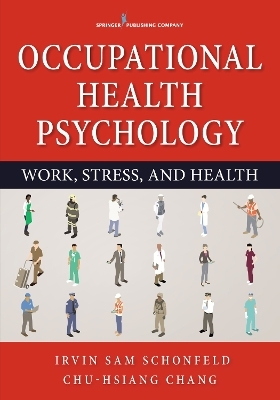
Occupational Health Psychology
Springer Publishing Co Inc (Verlag)
978-0-8261-9967-6 (ISBN)
"In general, the authors have provided readers with a thorough overview of research in many different areas of occupational health psychology. In our view, this textbook is most appropriate for graduate students and faculty, particularly given its emphasis on research and future directions for occupational health psychology. Advanced undergraduates, particularly those who have taken a research methods course, will also appreciate the text."--Gary W. Giumetti and Carrie A. Bulger, Quinnipiac University, Occupational Health Science Journal.
This comprehensive text for advanced undergraduate and graduate occupational health psychology (OHP) survey courses draws from the domains of psychology, public health, preventive medicine, nursing, industrial engineering, law, and epidemiology to focus on the theory and practice of protecting and promoting the health, well-being, and safety of individuals in the workplace and improving the quality of work life. The book will also appeal to anyone who is concerned with the corrosive effects of job stress.
The text addresses key psychosocial work issues that are often related to mental and physical health problems, including psychological distress, burnout, depression, accidental injury, obesity, and cardiovascular disease. It examines leadership styles as they impact organizational culture and provides specific recommendations for reducing employee-related stress through improved leader practices. Also addressed is the relationship between adverse psychosocial working conditions and harmful health behaviors, along with interventions aimed at improving the work environment and maximizing effectiveness. Additionally, the book discusses how scientists and practitioners in OHP conduct research and other important concerns such as workplace violence, work & life balance, and safety. The book reinforces learning with key concepts and findings, highlight tables containing intriguing examples of research and current controversies, and chapter summaries.
KEY FEATURES:
Comprises the first comprehensive text on OHP for undergraduate and graduate survey courses
Covers key issues in health psychology in the workplace such as stress, violence, work & life balance, and safety
Organized and written for easy access by students and faculty
Provides specific recommendations for reducing employee stress
Includes key concepts and findings, highlight tables, and end-of-chapter summaries
An Instructors Manual available to qualified adopters to help instructors develop exam and classroom discussion questions or homework assignments for each chapter
Irvin Sam Schonfeld, PhD, MPH, is a professor of psychology at the City College of the City University of New York (CUNY), and is a professor of educational psychology and psychology at the Graduate Center of CUNY. Chu-Hsiang (Daisy) Chang, PhD, is an associate professor at the Department of Psychology of Michigan State University.
Contents
Acknowledgments From Irvin Sam Schonfeld
Acknowledgments From Chu-Hsiang Chang
1. A Brief History of Occupational Health Psychology
Early Forerunners
Engels and Marx
Émile Durkheim
Max Weber and the Iron Cage
Taylor and Ford
Frederick Winslow Taylor
Henry Ford
World War I and the Interwar Years
Impact on Soldiers
The Interwar Years
Human Relations
Unemployment
From the World War II Era to the 1970s
World War II
Institute for Social Research
Tavistock and Human Relations
Changes in the British Mining Industry
Hans Selye
Stressful Life Events
Stress Research in Sweden
Developments in Sociology, Social Psychology, and Industrial Psychology
Richard Lazarus
Methodological Rigor in Research on Job Stress
OSHA and NIOSH
P–E Fit
Burnout
Decision Latitude and Job Demands
The 1980s to the Present
Two Groundbreaking Studies
Occupational Health Psychology
Work & Stress
APA–NIOSH Conference Series
Doctoral Programs in OHP
University of Nottingham
Journal of Occupational Health Psychology
ICOH–WOPS
European Academy of Occupational Health Psychology
Society for Occupational Health Psychology
Summary
2. Research Methods in Occupational Health Psychology
Research Designs
Experiment
Quasi-Experiment
Internal Validity of Experiments and Quasi-Experiments
Cross-Sectional Study
Case-Control Study
Longitudinal Study
Cohort Studies
Meta-Analysis
Two-Stage Meta-Analysis
One-Stage Meta-Analysis
Final Comment on Meta-Analyses
Other Research Designs in OHP
Diary Studies
Natural Experiment
Interrupted Time-Series
Qualitative Research Methods
Measurement
Reliability
Internal Consistency Reliability
Alternate Forms and Test–Retest Reliability
Interrater (Scorer) Reliability: Continuous Measures
Interrater Reliability: Categorical Measurement
Final Word on Reliability
Validity
Content Validity
Criterion-Related Validity
Construct Validity
Research Ethics
Summary
3. The Impact of Psychosocial Working Conditions on Mental Health
Assessing Mental Health in OHP Research
Psychological Distress and Depression
Burnout
The Impact of Job Loss on Mental Health
Two Pathways for Research on Unemployment
What the Research on Unemployment Has to Tell Us
Job Loss and Suicide
The Demand–Control(–Support) Model
Social Support Becomes Part of the Model
Measuring DCS Factors
Methodological Concerns
The Evidence Bearing on the Relation of the Demand–Control(–Support) Model to Depression and Distress
The DCS Factors and Excessive Alcohol Consumption
Workplace Support
The Impact of DCS Factors
The Job Demands–Resources (JD–R) Model and Conservation of Resources Model
The Evidence Bearing on the JD–R Model
The JD–R Model and Matching
Summing Up of the JD–R Model
The Effort–Reward Imbalance Model
Other Psychosocial Factors
Organizational Justice
Job Insecurity
Long Working Hours
Night Work and Shift Work
Stressful Occupational Events and Work-Related Social Stressors
Coping
Other Research Considerations
Reverse Causality
Controlling for Socioeconomic Status
Nonwork Stressors
Timing Waves of Data Collection
Decisions About Study Populations
Reliance on Self-Report Measures
Summary
4. Epidemiology, Medical Disease, and OHP
Cardiovascular Disease
A Riddle
Psychosocial Working Conditions Could Affect CVD Through Health Behaviors
Cigarette Smoking
Obesity and Weight Gain
Leisure Time Physical Activity
Summary
Biological Links From Psychosocial Working Conditions to CVD
Workplace Stressors and Human Biology
Cortisol and Epinephrine
Allostasis and Allostatic Load
Dysregulation of the HPA Axis and Other Harmful Effects
Summary
Depression and CVD
Burnout and CVD
Research Linking “Stress at Work” and Demand–Control Variables to CVD
Studies That Employed Imputation Strategies Linking DC Factors to CVD
Studies That Involve DC Factors That Were Assessed by Worker Self-Report
Focus on DC Factors in Women
Two-Stage Meta-Analysis
The DC and ERI Models Compared
“Mega-Study” of DC Factors
Summary of Studies Bearing on the DC and ERI Factors
The Relation of Job Loss to CVD Mortality
Job Insecurity and CVD
Long Working Hours and CVD
Bullying
Work Schedules and CVD
Socioeconomic Status and Health
Summary of Research on the Relation of Psychosocial Workplace Factors to CVD
Musculoskeletal Problems
Psychosocial Working Conditions and Musculoskeletal Problems
Evidence That Psychosocial Working Conditions Affect Musculoskeletal Problems
Two Meta-Analyses and a Systematic Review
Summary
Other Health-Related Outcomes
5. Workplace Violence and Psychological Aggression
Extent of Workplace Violence and Psychological Aggression
Prevalence of Homicide in the Workplace
Prevalence of Workplace Violence, Excluding Homicide
Prevalence of Psychological Aggression in the Workplace
Workplace Violence and Psychological Aggression Commonly Occur
Risk Factors for Violence in the Workplace and Worker-on-Worker Psychological Aggression
Risk Factors for Psychological Aggression by Workers Against Other Workers
Focus on Three Occupational Groups
Nurses
Hospital Climate
A Small Corps of Patients and the Context of Assaults
Summary of the Nursing Findings
Teachers
What Qualitative Research Has to Say
Official Data on Assault
Data Obtained From the Teachers Themselves
Summary of the Teacher Findings
Bus Drivers
Consequences of Violence Exposure at the Workplace
Cross-Sectional Research on the Consequences of Exposure to Workplace Violence
Case-Control Research on the Consequences of Exposure to Workplace Violence
Longitudinal Research on the Consequences of Exposure to Workplace Violence
Longer-Term Longitudinal Studies
Shorter-Term Longitudinal Studies
Summing up the Consequences of Violence Exposure
Consequences of Workplace Psychological Aggression
Longitudinal Research on the Consequences of Exposure to Workplace Psychological Aggression
Longitudinal Studies on Distress and Depression With Longer Time Lags
Longitudinal Studies on Distress and Depression With Shorter Time Lags
Bidirectional Effects
Outcomes Other Than Distress and Depression
Coping
Summary
6. Organizational Climate and Leadership
Organizational Climate: A Brief History
Levels of Analysis
Dimensions of Organizational Climate
Safety Climate
Antecedents of Safety Climate
Safety-Related Outcomes of Safety Climate
Other Effects of Safety Climate
Mistreatment Climate
Psychosocial Safety Climate
Other Climates Relevant to Occupational Health Psychology
Organizational Leadership: A Brief History
Contemporary Leadership Theories and Occupational Health
Transformational Leadership
Leader–Member Exchange
Abusive Supervision
Summary
7. OHP Research on Specific Occupations
Teachers
Mental Disorder, Suicide, and Physical Disorder
Within-Occupation Research
Summary
Nurses
Mental Disorder and Suicide
Within-Occupation Research
Summary
Combat Soldiers
Posttraumatic Stress Disorder
Mental Disorder and Brain Injury
Leadership
Sexual Harassment
Suicide
Summary
Postscript
First Responders
Police Officers
Summary
Firefighters
Summary
9/11
9/11 First Responders Who Were Police Officers
9/11 First Responders Who Were Firefighters
Children of 9/11 First Responders
Summary
Construction Workers
Occupational Stress and Safety
Occupational Health Issues Unique to Construction Workers
Summary
Agricultural Workers
Occupational Stress
Occupational Safety
Occupational Health Issues Unique to Agricultural Workers
Summary
8. Occupational Safety
Risk Factors in the Physical Work Environment
Occupational Health Psychology and Occupational Safety
Individual Antecedents of Safety Performance and Workplace Accidents and Injuries
Demographics
Personality
Ability Factors
Motivation-Related Differences
Situational Antecedents of Safety Performance and Workplace Accidents and Injuries
Job Characteristics
Shift Work
Implications of Considering Individual and Situational Antecedents for Safety
Summary
9. Work–Family Balance
Negative Work–Family Interface: Work–Family Conflict
Situational Antecedents of WFC
Dispositional Antecedents of WFC
Outcomes of WFC
Experience Sampling and Longitudinal Research
Cross-National Research
Positive Work–Family Interface: Work–Family Enhancement (WFE)
Situational Antecedents of WFE
Dispositional Antecedents of WFE
Outcomes of WFE
Experience Sampling and Longitudinal Research
Work–Family Balance
Consideration of the Broader Context
Summary
10. Interventions in Occupational Health Psychology
Integrated Model for Intervention in OHP
Primary Interventions to Improve Work–Life Balance
Secondary Interventions to Improve Work–Life Balance
Tertiary Interventions to Improve Work–Life Balance
Primary Interventions to Improve Physical Health and Safety
Secondary Interventions to Improve Physical Health and Safety
Tertiary Interventions to Improve Physical Health and Safety
Primary Interventions to Improve Psychological Health and Well-Being
Secondary and Tertiary Interventions to Improve Psychological Health and Well-Being
Summary
11. The Future of Occupational Health Psychology
The Future of OHP, Chapter by Chapter
Mental Health
Money
Personality and Social Factors
Job Crafting
Physical Health
Intermediate Pathways to CVD
Stroke
Underrepresented Groups
Workers Transitioning Into Retirement
Aggression in the Workplace
Work-Related Mistreatment via the Internet
Organizational Climate and Leadership
Industry-Specific Research
Leadership
Research on Specific Occupations
Combat Soldiers
Police Officers and Firefighters
Correctional Officers
The Self-Employed
Teaming With Workers to Develop Research Ideas
Safety
Worker Empowerment and Safety
Work–Family Balance
Families Responsible for Other Kinds of Care
The Self-Employed
Physicians
Interventions in the Workplace
Learning From Failure
Total Worker Health™
Final Thoughts
Index
| Erscheinungsdatum | 05.10.2016 |
|---|---|
| Zusatzinfo | 30 Illustrations; 30 Illustrations |
| Verlagsort | New York |
| Sprache | englisch |
| Maße | 178 x 254 mm |
| Themenwelt | Sachbuch/Ratgeber ► Gesundheit / Leben / Psychologie |
| Geisteswissenschaften ► Psychologie ► Arbeits- und Organisationspsychologie | |
| Medizin / Pharmazie ► Medizinische Fachgebiete ► Arbeits- / Sozial- / Umweltmedizin | |
| ISBN-10 | 0-8261-9967-4 / 0826199674 |
| ISBN-13 | 978-0-8261-9967-6 / 9780826199676 |
| Zustand | Neuware |
| Haben Sie eine Frage zum Produkt? |
aus dem Bereich


